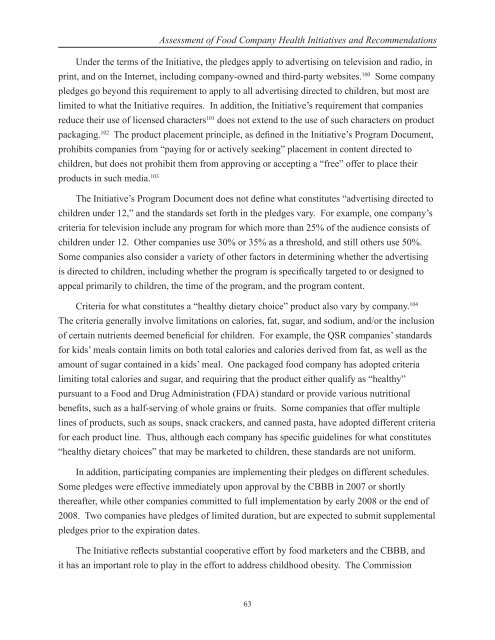Marketing Food to Children and Adolescents - Federal Trade ...
Marketing Food to Children and Adolescents - Federal Trade ...
Marketing Food to Children and Adolescents - Federal Trade ...
You also want an ePaper? Increase the reach of your titles
YUMPU automatically turns print PDFs into web optimized ePapers that Google loves.
Assessment of <strong>Food</strong> Company Health Initiatives <strong>and</strong> Recommendations<br />
Under the terms of the Initiative, the pledges apply <strong>to</strong> advertising on television <strong>and</strong> radio, in<br />
print, <strong>and</strong> on the Internet, including company-owned <strong>and</strong> third-party websites. 100 Some company<br />
pledges go beyond this requirement <strong>to</strong> apply <strong>to</strong> all advertising directed <strong>to</strong> children, but most are<br />
limited <strong>to</strong> what the Initiative requires. In addition, the Initiative’s requirement that companies<br />
reduce their use of licensed characters 101 does not extend <strong>to</strong> the use of such characters on product<br />
packaging. 102 The product placement principle, as defined in the Initiative’s Program Document,<br />
prohibits companies from “paying for or actively seeking” placement in content directed <strong>to</strong><br />
children, but does not prohibit them from approving or accepting a “free” offer <strong>to</strong> place their<br />
products in such media. 103<br />
The Initiative’s Program Document does not define what constitutes “advertising directed <strong>to</strong><br />
children under 12,” <strong>and</strong> the st<strong>and</strong>ards set forth in the pledges vary. For example, one company’s<br />
criteria for television include any program for which more than 25% of the audience consists of<br />
children under 12. Other companies use 30% or 35% as a threshold, <strong>and</strong> still others use 50%.<br />
Some companies also consider a variety of other fac<strong>to</strong>rs in determining whether the advertising<br />
is directed <strong>to</strong> children, including whether the program is specifically targeted <strong>to</strong> or designed <strong>to</strong><br />
appeal primarily <strong>to</strong> children, the time of the program, <strong>and</strong> the program content.<br />
Criteria for what constitutes a “healthy dietary choice” product also vary by company. 104<br />
The criteria generally involve limitations on calories, fat, sugar, <strong>and</strong> sodium, <strong>and</strong>/or the inclusion<br />
of certain nutrients deemed beneficial for children. For example, the QSR companies’ st<strong>and</strong>ards<br />
for kids’ meals contain limits on both <strong>to</strong>tal calories <strong>and</strong> calories derived from fat, as well as the<br />
amount of sugar contained in a kids’ meal. One packaged food company has adopted criteria<br />
limiting <strong>to</strong>tal calories <strong>and</strong> sugar, <strong>and</strong> requiring that the product either qualify as “healthy”<br />
pursuant <strong>to</strong> a <strong>Food</strong> <strong>and</strong> Drug Administration (FDA) st<strong>and</strong>ard or provide various nutritional<br />
benefits, such as a half-serving of whole grains or fruits. Some companies that offer multiple<br />
lines of products, such as soups, snack crackers, <strong>and</strong> canned pasta, have adopted different criteria<br />
for each product line. Thus, although each company has specific guidelines for what constitutes<br />
“healthy dietary choices” that may be marketed <strong>to</strong> children, these st<strong>and</strong>ards are not uniform.<br />
In addition, participating companies are implementing their pledges on different schedules.<br />
Some pledges were effective immediately upon approval by the CBBB in 2007 or shortly<br />
thereafter, while other companies committed <strong>to</strong> full implementation by early 2008 or the end of<br />
2008. Two companies have pledges of limited duration, but are expected <strong>to</strong> submit supplemental<br />
pledges prior <strong>to</strong> the expiration dates.<br />
The Initiative reflects substantial cooperative effort by food marketers <strong>and</strong> the CBBB, <strong>and</strong><br />
it has an important role <strong>to</strong> play in the effort <strong>to</strong> address childhood obesity. The Commission<br />
63

















